Heating furnace professor butakov engineer - europe is
Without challenging the unique properties of gas boilers and heat pumps, modern solid-fuel stoves confidently take their place in country and country houses. Compact discreet design boilers look organic in any setting, and long burning leaves free time, which you can devote to your favorite business.
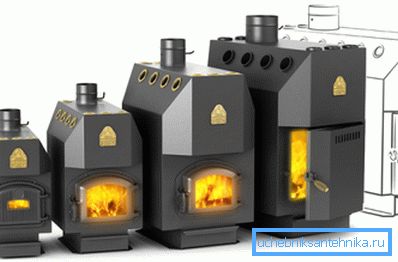
Highlight worth attention
The beginning of the 21st century was marked by the appearance of a stove, named after the Ural professor Sergei Yefimovich Butakov.
A wide range of models has been tested at various points in Russia, earning wide popularity:
- units successfully heat rooms with a capacity of 100 (heating furnace Professor Butakov - Student) to 1200 m3 (model Academician);
- take any solid fuel - coal and wood, peat and cardboard;
- operated at ambient temperatures from +40 to -60 ° C;
- dimensions save usable space.

Depending on the model, it is possible to use an air-jet boiler:
- in a private house and cottage;
- greenhouse;
- basement and garage;
- change houses and warehouses;
- mobile stations.
The price of hot air boilers of Professor Butakova varies depending on the model, the materials used, the type of fuel and the conscience of the distributor. If Butakov Gymnazist on the wood will cost more than 9,500 rubles, then the cost of the coal furnace Professor will reach 35,500.
Butakova's stove - a view from the inside
The furnace is a simple but original design:
- welded 2-chamber case;
- tubes built into it;

- firebox;
- grate bars (for some models, the fuel burns on the bottom of the furnace at the ashes);
- an ashpit where a special ash box is located;
- a door of a fire chamber from metal or with an insert from heat resisting glass;
- ash valve; thrust regulated by it;
- pipe with vertical or side liner.
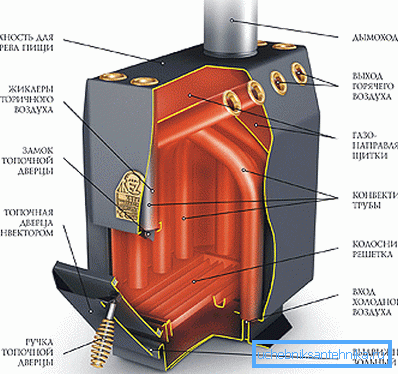
The principle of convection is put in the basis of the furnace - heat from the bottom up. Firewood / coal does not burn, but intensively smolders, saving fuel and increasing heat transfer. It is important to observe the condition - do not raise the temperature above 350, because the scaling of ferrous metal occurs already at 400 ° C.
Note! The first “run” of a new construction should be in the burning mode for 1–2 hours. Silicone paint and industrial oil will smell specifically, but it will soon pass.
Good is never enough
Heating furnaces Professor Butakov have undeniable advantages:
- Record large heating surface.
- Long burning after one tab - from 8 to 12 hours.
- Convective tubes that enhance heat transfer, significantly increase efficiency.
- The top plane can be used for cooking.
- The ash box allows you to empty it at any time, simply by taking it out of the chamber..
- Grate bars provide a uniform burning process.

The drawbacks of the unit are based on feedback from their owners:
- The ash box loosely enters the chamber, loosely adhering to the front wall, “sucking in” excess air.
- The deformation of the front panel under the furnace door.
- Inconvenient procedure for cleaning a vertical pipe, for which the oven has to be disconnected.
In fairness, it is necessary to reassure potential buyers - such defects depend on the manufacturer, which may well be an unknown clone.
The problems of sealing the ash pan were solved by the use of a thermal cord and a latch. Chimney joins tee from behind. The use of such a construction facilitated the cleaning of the furnace chimney pipe — it does not have to be disconnected, soot accumulates mainly in the fitting.
Note! If you are afraid that vulnerable parts of convective pipes may burn out, stir a portion of ash in silicate glue (liquid glass) and coat these areas. Wonderful recipe taken from practice and harm certainly does not bring.
These different similar stoves
The range of air-heating boilers is constantly improving, as well as their working qualities. The heating stove by Professor Butakov. The first-generation high-school gymnast was produced without a cooking stove (a special circle), which appeared later. The power of Gymnazist-1 and 2 is 5, the model number 3 - 8 kW, which is suitable for household and utility rooms.
The lack of obsolete models of this series is:
- in a vertical arrangement of the pipe, in which soot and condensate sink;
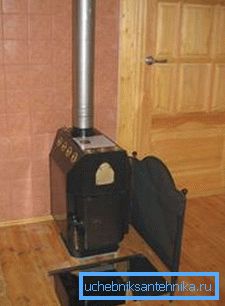
- in the early models there are no grate, and in the later they are steel;
- cleaning the chimney involves disconnecting it from the stove.
Model Engineer has a high sales rating and heats rooms up to 250 m3. In this unit there is also a vertical chimney, there are no grate bars and the combustion takes place in the gas generation mode with an output power of 15 kW.
Professor Butakov Student organically fits into the space of country and private houses of small size or well-insulated houses of large areas - up to 150 m2. The furnace is equipped with pig-iron grates, the pipe joins a tee in which soot is showered.
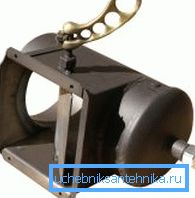
The chimney diameter increased to 120 mm, and the walls became thinner. The increased cross-section of the chimney accelerated the movement of air by 35%, at the same time increasing heat transfer, which, together with a 9 kW power, gives the boiler a special “charm”.
Installation rules
All operations can be done by hand, with particular attention to the tightness of the chimney pipe:
- The place of installation of the furnace is covered with sheets of metal on 10 mm cardboard from asbestos.
- Sections of walls in close proximity are insulated with the same asbestos cardboard or 25 mm layer of plaster to a height of 250 mm above the surface of the furnace.
- In front of the stove, place a metal sheet 700x500 mm with the long side against the firebox.
- Identify, cut and insulate with a metal or basalt wool hole for the pipe.
- Place the unit on the prepared area, preferably on a stand made of bricks.
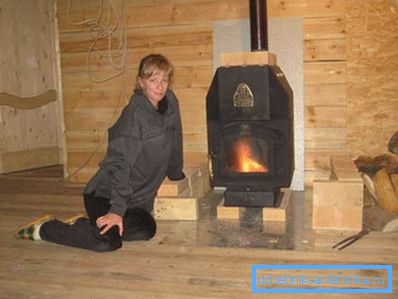
- Connect the pipe with a tee and withdraw it into the hole, which is isolated with basalt wool.
- Install the chimney through the roof to the outside - it should rise 500 mm above the surface.
- The section of the pipe, which will be exposed to subzero temperature, should be covered with thermal insulation.
Note! The instruction recommends sealing the pipe joints with a heat-resistant sealant.

Summarizing
The use of a Butakova heating furnace does not have to be an alternative. The decision made initially to heat your home with this particular unit will not disappoint your expectations. The quiet crackling of firewood and soft reflections of the flame in the glass door will create a unique aura of comfort, and the “omnivorousness” of the furnace will allow you not to focus on one type of fuel.
Understand the subtleties of adjusting the process of smoldering-burning will help you proposed in the video.